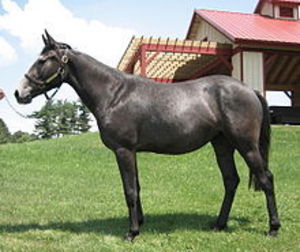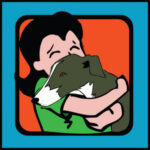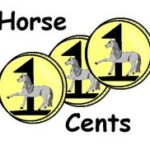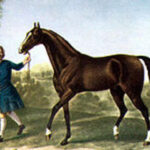In the 1900s, it was very easy to spot the physical differences between quarter horses and thoroughbreds. Back then, quarter horses were often smaller, more close-coupled, more muscular and more level-headed. Open up any horse breed book published before 2000 and time after time you’ll read the description that quarter horses are built more like bulldogs while thoroughbreds are built more like greyhounds.
But times change and so does the fashions in horse breeding. In the early 1900s, the old joke was, “A quarter horse is a thoroughbred without papers.” Now, the joke has come back to haunt, because a modern quarter horses is a thoroughbred with papers with the American Quarter Horse Association. It is very difficult to differentiate a modern quarter horse from a modern thoroughbred.
Early Quarter Horse Breeding
Quarter horses originated in the American colonies on the East Coast, particularly Virginia and Rhode Island. The first recordings of American colonials to importing horses from Europe were about 1620. There were no horses in North or South America at the time of the European conquests. But horses did arrive with Spanish conquistadors and French colonials in the 1500s and 1600s, so the English colonials probably did have some access to horses and added the European imports to the mix.
According to Judith Dutson, author of Storey’s Illustrated Guide to 96 Horse Breeds of North America, imported thoroughbreds were put to local Spanish barbs, mustangs, Andalusians and the small, wiry steeds of the Chickasaw Indians. The resulting horses exceeded at quarter-mile races and became known as Short Horses or Quarter Pathers. The most influential sire of the time was Old Snipe of Spanish descent.
And then in 1752, a short but stocky English thoroughbred named Janus was imported to Virginia. He “improved” the Quarter Pathers, although just how remains vague to modern readers. But the trend had been set and thoroughbreds have been added and re-added to the quarter horse mix ever since. Most of today’s modern quarter horses have thoroughbred somewhere just a few generations back.
Four Types of Quarter Horses
The resulting mix has brought about four different types of quarter horses. The Western Pleasure type is almost identical to the average thoroughbred. The quarter horse conformation champions are the heavier bulldog type with thick necks, heavily layered shoulders and small hooves. The racing type of quarter horse is a mixture of the two extremes.
The last type of quarter horse is most true to the original Quarter Pathers. This is the ranch horse or cutter type. This is more Spanish in build without the exaggerated muscling or the long, lean thoroughbred lines. Sometimes this type can become quite “weedy”, or wiry and tough like a mustang.
Thoroughbred Types
Modern thoroughbreds also have a variety of conformational types. The racing thoroughbred is the closest to a cutting quarter horse, especially if they have been given many courses of steroids and allowed to overeat. The hunter or sporting type is the most usual type found. These are long yet solid horses built somewhat like an Oldenburg or Holsteiner when they mature.
Some thoroughbreds bred for riding, racing or companionship strongly resemble the weedy quarter horses or tough mustangs. Although not in fashion, these thoroughbreds often are stellar in their athletic ability, character and friendliness. They act more like quarter horses than quarter horses.
References
- International Encyclopedia of Horse Breeds Bonnie Hendricks. University of Oklahoma Press, 1995.
- Storey’s Illustrated Guide to 96 Horse Breeds of North America. Judith Dutson. Storey Publishing, 2005.
- The Official Horse Breeds Standard Book. Fran Lynghaug. Voyageur; 2009.
- Champion Horses. Maurizio Bongianni. Random House; 1986.
- Know the American Quarter Horse. Bill Weikel. Farnam Horse Library; 1971.
- The Quarter Horse. Walter T. Osborne. Grosset & Dunlap; 1967.
- Author’s personal experience








